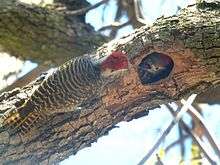Cardinal woodpecker
| Cardinal woodpecker | |
|---|---|
.jpg) | |
| | |
| Scientific classification | |
| Kingdom: | Animalia |
| Phylum: | Chordata |
| Class: | Aves |
| Order: | Piciformes |
| Family: | Picidae |
| Genus: | Dendropicos |
| Species: | D. fuscescens |
| Binomial name | |
| Dendropicos fuscescens (Vieillot, 1818) | |
The cardinal woodpecker (Dendropicos fuscescens) is a widespread and common resident breeder in much of Sub-Saharan Africa. It occurs in a wide range of habitats, ranging from dense forest to thorn bush. They are fairly vocal and are easily identified by their call notes. The sexes are distinguishable by their head patterns.
Description

Like other woodpeckers, this species has a straight pointed bill, a stiff tail to provide support against tree trunks, and zygodactyl or “yoked" feet, with two toes pointing forward, and two backward. The long tongue can be darted forward to capture insects.[2]
This bird measures 14 to 15 cm (5.5 to 5.9 in) from bill tip to tail tip, and its body shape is typical of a woodpecker. Its back plumage is dull olive in colour, and is marked with paler dots and bands. The underparts are white, heavily streaked with black, and the rump plumage is tawny. The white throat and face are separated by a conspicuous black malar stripe, and the fore crown is olive brown. As with other woodpeckers, the head pattern varies with age and sex. The male has a red hind crown and nape, the female has a dark hind crown and black nape. Juvenile males have a red hind crown and black nape. The small crest is raised when the bird is excited.[2]
Range, habitat and status
The Cardinal woodpecker is native to tropical parts of western and central Africa. Its range includes Angola, Benin, Botswana, Burkina Faso, Burundi, Cameroon, Central African Republic, Chad, Congo, Democratic Republic of Congo, Djibouti, Eritrea, Ethiopia, Gabon, Gambia, Ghana, Guinea, Guinea-Bissau, Ivory Coast, Kenya, Lesotho, Malawi, Mali, Mauritania, Mozambique, Namibia, Nigeria, Rwanda, Senegal, Sierra Leone, Somalia, South Africa, South Sudan, Sudan, Swaziland, Tanzania, Togo, Uganda, Zambia and Zimbabwe.[1]
It is found in a wide range of habitats from dense forest to thorn bush. The species has an extremely wide range and is common in much of this range. No particular threats have been recognised and the IUCN has rated its conservation status as being of "least concern".[1]
Behaviour
The cardinal woodpecker often occurs in small family groups or may join small mixed flocks. Forages mainly in the lower storeys of trees and among shrubs and vines, on maize stalks and reeds. Pecks rapidly and probes dense vegetation, clambering along and hanging from small twigs. Like other woodpeckers, this species is an insectivore. It is frequently seen, and regularly drums softly. The call is a high-pitched krrrek-krrrek-krrrek. It nests in a tree hole, unlined apart from wood chippings.[2]
Nesting

Like other woodpecker species they usually excavate a new breeding cavity every season, which takes a few weeks. With this species a nest is not located in the vicinity of the previous season's nest.[3] The entrance hole is oval in shape, and situated about 2 meters from the ground. The glossy white eggs, 1 to 3 in number, are laid on a layer of wood chips.[3] Incubation starts when the full clutch has been laid at one day intervals, and this usually occurs in spring or early summer. Both parents partake in incubation, brooding and feeding.[3] The clutch is incubated for about 12 days, and the chick leaves the nest in some 27 days, when it is immediately independent. The scaly-throated honeyguide is a recorded nest parasite.[3]
Subspecies
The West African subspecies is distinctive. It has streaking on the face and chin, a yellow-buff ground colour to the underparts, and greener upperparts (except the juvenile), with weaker, yellower spotting.[2]
References
- 1 2 3 BirdLife International (2012). "Dendropicos fuscescens". IUCN Red List of Threatened Species. Version 2013.2. International Union for Conservation of Nature. Retrieved 26 November 2013.
- 1 2 3 4 Hans Winkler; David A. Christie (2010). Woodpeckers. Bloomsbury Publishing. p. 4. ISBN 978-1-4081-3504-4.
- 1 2 3 4 Tarboton, Warwick (2001). A Guide to the Nests and Eggs of Southern African Birds. Cape Town: Struik. pp. 137–139. ISBN 1-86872-616-9.
| Wikimedia Commons has media related to Dendropicos fuscescens. |
- Barlow, Wacher and Disley, Birds of The Gambia, ISBN 1-873403-32-1
- Sinclair, Hockey and Tarboton, SASOL Birds of Southern Africa, ISBN 1-86872-721-1
External links
- Cardinal woodpecker - Species text in The Atlas of Southern African Birds
